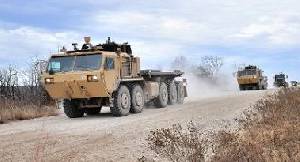Articles >>
Unmanned Vehicle Demo Showcases Leap-Ahead Technology
Category: Army

Working closely with Lockheed Martin and a conglomeration of Army technology, acquisition and user community stakeholders, the U.S. Army Tank Automotive Research Development and Engineering Center successfully demonstrated an unmanned military convoy Jan. 14 at Fort Hood, Texas. From a rooftop in the Fort Hood training area, military and industry VIPs saw firsthand how the Autonomous Mobility Appliqué System, or AMAS, enabled two driverless Palletized Loading System prime movers and an M915 tractor trailer truck to seamlessly interact with a manned Humvee gun truck escort. The convoy negotiated oncoming traffic, followed rules of the road, recognized and avoided pedestrians and various obstacles, and then used intelligence and decision-making abilities to re-route their direction through a maze of test areas to complete both complex urban and rural line haul missions. As the ground systems expert within the U.S. Army Research, Development and Engineering Command, TARDEC develops, integrates and sustains the right technology solutions to address ever-changing threats and shifts in strategic, technological and fiscal environments. Flexibility and adaptability are vital to future systems, and AMAS is designed to provide a wide range of military vehicle platforms with optionally-manned capabilities that will increase safety and provide the warfighter with additional flexibility. "We're not looking to replace Soldiers with robots. It's about augmenting and increasing capability," said Col. Chris Cross, chief of Science and Technology at the Army Capabilities Integration Center. Equipped with GPS, Light Detecting and Ranging systems, known as LIDAR, Automotive radar, a host of sensors and other high-tech hardware and software components, the common appliqué kit's intelligence and autonomous decision-making abilities can be installed in practically any military vehicle, transforming an ordinary vehicle into an optionally manned version. AMAS can also keep personnel out of harm's way and provide Soldiers on manned missions with increased situational awareness and other safety benefits. For instance, AMAS also features collision mitigation braking, lane-keeping assist and a roll-over warning system, electronic stability control and adaptive cruise control. During manned missions, these additional safety features could theoretically increase Soldier performance. The robotic mode frees up the vehicle crew to more closely watch for enemy threats, while still leaving them the option of manually taking control of the vehicle when necessary. "The AMAS hardware and software performed exactly as designed and dealt successfully with all of the real-world obstacles that a real-world convoy would encounter," said AMAS Program Manager David Simon, with Lockheed Martin Missiles and Fire Control. AMAS development aligns with Army goals for the Future Force. At an Association of the United States Army breakfast in Arlington, Va., Jan. 23, Army Chief of Staff Gen. Raymond Odierno talked about the Army Modernization Strategy and the difficult decisions ahead. "What is that leap-ahead technology that we need that could make a real difference for our Soldiers on the ground?" Odierno asked. "What is the technology that allows us to decrease the weight so we can be more expeditionary? I need tactical mobility for the future. We need to move towards mobility and try to determine how we sustain survivability while increasing mobility." In his just-released CSA Strategic Priorities, Odierno added that we must prioritize Soldier-centered modernization and procurement of proven technologies so that Soldiers have the best weapons, equipment and protection to accomplish the mission. Another AMAS demonstration with more vehicles and more complex notional scenarios is scheduled for later this year. "We are very happy with the results, but the AMAS must undergo more testing before it becomes deployable," said TARDEC AMAS Lead Engineer Bernard Theisen. "The vehicles and systems are replaceable, but nothing can replace the life of a Soldier. These systems keep Soldiers safe and make them more efficient," he said. TARDEC is the ground systems expert within RDECOM. It provides engineering and scientific expertise for Department of Defense manned and autonomy-enabled ground systems and ground support systems; serves as the nation's laboratory for advanced military automotive technology; and provides leadership for the Army's advanced Science and Technology research, demonstration, development and full life cycle engineering efforts. ABOUT TARDEC
TARDEC is part of the U.S. Army Research, Development and Engineering Command, which has the mission to develop technology and engineering solutions for America's Soldiers. TARDEC is also a TACOM Life Cycle Management Command partner. In this capacity, it is responsible for critical technology functions within the "acquisition -- logistics -- technology" system life-cycle model, including: technology maturation and integration; technology subject-matter expertise; systems-level engineering analysis; and systems engineering. TARDEC provides engineering support for more than 2,800 Army systems and many of the Army's and DoD's top joint development programs. The organization is responsible for maximizing the research, development, transition and sustainment of technologies and integration across ground systems. RDECOM is a major subordinate command of the U.S. Army Materiel Command. AMC is the Army's premier provider of materiel readiness -- technology, acquisition support, materiel development, logistics power projection, and sustainment -- to the total force, across the spectrum of joint military operations. If a Soldier shoots it, drives it, flies it, wears it, eats it or communicates with it, AMC delivers it. |
US Army |
Bradley Driving… In Stereo
06.07.2018
Lockheed Martin Autonomous Driving System Tops 55,000 Miles in Extended Army Testing
30.11.2017
SAAB Chosen As Sub-Contractor For The Ajax Virtual Crew Turret Trainer
14.10.2017
GM Outlines Possibilities for Flexible, Autonomous Fuel Cell Electric Platform
13.10.2017
Lockheed Martin Electro-Optical Systems
Lockheed Martin Vought Systtems Corporation
Lockheed Martin Missiles and Fire Control
Defense Advanced Research Projects Agency - DARPA
Discuss
